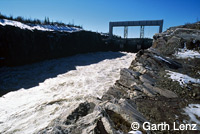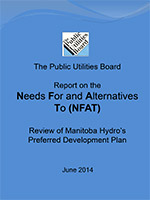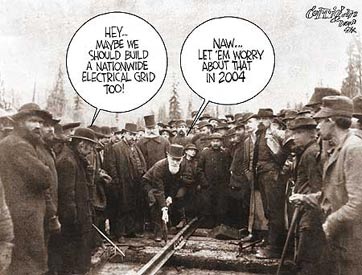
Manitoba Hydro Projects
Lake WinnipegManitoba Minnesota Transmission ProjectBiPole III 500 kV HVDC Transmission ProjectKeeyask Generation ProjectChurchill River Diversion In 1966, officials from Manitoba Hydro, the Canadian federal government and the Manitoba government under Premier Duff Roblin signed a formal agreement to proceed with the Lake Winnipeg and Churchill River Diversion Project. This was an ambitious and expensive ($2.6 billion) program that would first divert the flow of the Churchill River into the Nelson River. Further supported by a regulated escapement from Lake Winnipeg and associated "outlet lakes", the Nelson River would then have abundant and excessive potential for power generation upon demand. In 1966, officials from Manitoba Hydro, the Canadian federal government and the Manitoba government under Premier Duff Roblin signed a formal agreement to proceed with the Lake Winnipeg and Churchill River Diversion Project. This was an ambitious and expensive ($2.6 billion) program that would first divert the flow of the Churchill River into the Nelson River. Further supported by a regulated escapement from Lake Winnipeg and associated "outlet lakes", the Nelson River would then have abundant and excessive potential for power generation upon demand.While the Churchill River was recognized as having the capability for hydro-electric development with a discharge of 35,700 cubic feet/second, development had already begun on the Nelson River and it was seen as "economically more attractive to divert a major portion of the Churchill River flow into the Nelson River than to develop the hydro- electric energy potential of the Churchill River". The terms of the agreement allowed the government of Manitoba:
The Canadian federal government would also meet the expense of building a 560 mile long transmission line to southern Manitoba. As well, and even with the low level diversion alternative in place, over 100,000 acres (40,470 ha) of shoreline were inundated directly, and many thousands of others affected by ancillary developments. View Manitoba Hydro Churchill River Diversion pageDownload Churchill River Diversion Project Information (PDF) Planning for Development and a Lack of Concern for Native Peoples & Culture  The conception of the Churchill River Diversion project, as previously discussed, was part and parcel of a post World War II vision of economic prosperity through the exploitation of natural resources in northern Manitoba. The conception of the Churchill River Diversion project, as previously discussed, was part and parcel of a post World War II vision of economic prosperity through the exploitation of natural resources in northern Manitoba.In criticizing the decision to proceed with development, this was best expressed by Dr. Robert Newbury, a Professor of Civil Engineering at the University of Manitoba: Nowhere is the cost of the loss of the Churchill River calculated. Its existence, aesthetics, native community options, ecology, and unique role of creating a livable environment in an otherwise harsh land are considered to be worthless in the energy budget. Newbury went even further, questioning the economic viability and need for the project altogether: For almost two decades there is sufficient Hydro-electric power ready to be developed on the already-committed Nelson River without touching the Churchill. The Nelson River power potential can meet Manitoba's needs until 1991. Consequently a study was carried out in the latter part of 1966 by the University of Manitoba (Duckworth Report) to outline the terms of reference for a major investigation of environmental, social and economic impacts of the high level diversion of the Churchill River system. Even before these studies could be initiated, however, this confidential report called for alternatives to the project, or at the least, a project redesign to minimize the effects of impoundment on Southern Indian Lake and the South Indian Lake community. From its very conception in 1966, it was known that the high level diversion project would necessitate a relocation of the entire South Indian Lake settlement. In the 1969 public hearings, therefore, considerable opposition resulted. This opposition came from Church, environmental and university groups who were concerned with disruption of the self-sufficient South Indian Lake community, the lack of impact assessment studies and the Manitoba government's refusal to publicly release its own internal reports on development. The new premier, Edward Schreyer, and his New Democratic government immediately reassured the South Indian Lake community and opponents of Churchill River diversion that the project would be subject to the closest scrutiny. To appease opponents of the project, two outspoken critics, Professors Cass Booy and Robert Newbury, were appointed to the Manitoba Water Commission to review plans and to continue holding public hearings. David Cass-Beggs was also appointed as a new general manager of Manitoba Hydro. For critics of the Churchill River diversion, the change in government seemed to indicate a change in philosophy regarding the north. On September 20th, 1970, Premier Schreyer announced that Churchill River diversion would proceed and, in November, Manitoba Hydro was granted the necessary water license. The Nelson House Indian band was not formally advised nor consulted about the impacts of the Churchill River diversion until the fall of 1973 - a full seven years after the first public announcement of Manitoba Hydro's intent. This was so in spite of the fact that this project would raise water levels in some areas as much 30 ft or more, inundating and otherwise altering reserve lands and traditional resource areas. For full citations and further content: Source: Footprints of Wasahkacahk
Norway House Cree Call for Public Process  Norway House Cree Nation Chief Marcel Balfour and Council called on Manitoba to establish a "public, open and transparent process" to review the Lake Winnipeg Regulation and Churchill River Diversion Project (LWRCRDP) on October 30th, 2009. Norway House Cree Nation Chief Marcel Balfour and Council called on Manitoba to establish a "public, open and transparent process" to review the Lake Winnipeg Regulation and Churchill River Diversion Project (LWRCRDP) on October 30th, 2009.In 1973, Manitoba Hydro began construction on the LWCRDP for a series of dams to regulate water levels on Lake Winnipeg and divert the Churchill River under an interim licence granted under the Manitoba Water Power Act. Manitoba Hydro now seeks a 50-year final licence for the Churchill River Diversion Project and a separate licensing process for the regulation of Lake Winnipeg. The Manitoba government requested Norway House Cree Nation participate in consultation about Hydro's request for a final licence that is only for the Churchill-Nelson River Diversion. Chief Balfour stated "In 1973 Manitoba and Canada said the flooding of our lands were justified to provide power needed of the Province. Today, Manitoba Hydro has a very different focus - maximizing export revenues. We will seek...a system-wide look at how Hydro manages and operates rivers and lakes that supply water to Hydro's dams, and the outstanding issues regarding implementation of the (Northern Flood Agreement) Treaty." "Together with the Province's special audit to investigate whistleblower claims of export risks and mismanagement, this will provide everyone with a timely and once in a lifetime opportunity to look at Manitoba Hydro's projects and operations and see if in fact Manitoba Hydro's power is actually 'green'."
View October 30, 2009 Norway House Cree Nation press release Source: StreetInsider.com, Norway House Cree Nation |
Comment |
 |
| Article: Churchill River Diversion - After Thirty Years, By Gaile Whelan Enns Published by The Drum, February 22, 2010 During 2009 Manitoba Water Stewardship and Manitoba Hydro started to move from interim to permanent water power licences for the Churchill River Diversion (CRD). Only interim water power licences are currently in place. Manitoba Hydro has now requested that current interim water power licences be combined into one permanent licence, for 50 years.
|
|
Winnipeg River Dams The Winnipeg River flows 235 kilometers from the Norman Dam in Kenora Ontario, westward to Lake Winnipeg in Manitoba. Used by First Nations for thousands of years, the river system was important for trade, travel, harvesting, and access to settlements. The river was also a major transportation route for fur traders and early explorers.
The Winnipeg River flows 235 kilometers from the Norman Dam in Kenora Ontario, westward to Lake Winnipeg in Manitoba. Used by First Nations for thousands of years, the river system was important for trade, travel, harvesting, and access to settlements. The river was also a major transportation route for fur traders and early explorers.
The first hydroelectric plant on the Winnipeg River was constructed by the Winnipeg Electric Street Railway near Pinawa in 1906. This plant operated until 1951, when it was decommissioned to improve water flow to other Winnipeg River Stations. Six hydroelectric dams bisect the Winnipeg River in Manitoba, generating a total of 583 megawatts annually. From east to west, generating stations are located at Pointe du Bois, Slave Falls, Seven Sisters Falls, McArthur Falls, Great Falls and Pine Falls. All Manitoba dams are owned and operated by Manitoba Hydro. Point du Bois is the oldest power plant still operating on the Winnipeg River. Construction took 20 years being completed in 1926. Stretching 135 meters across the river Point du Bois has 16 turbines and a capacity of 78 megawatts. Slave Falls was constructed between 1928 and 1948. The powerhouse is 180 meters long with a capacity of 67 megawatts. Seven Sisters is the largest Winnipeg River producer of electricity with a capacity of 165 megawatts. The powerhouse was built from 1929 to 1931. Additional units were added between 1948 to 1952, doubling energy output. Today the powerhouse stretches 128 meters across a waterfall drop of 18.6 meters. McArthur was completed in 1955, is the smallest and most recently constructed generating station on the Winnipeg River with a capacity of 55 megawatts. Great Falls was developed by Winnipeg Electric Railway Company between 1914 to 1928. Now owned by Manitoba Hydro, the powerhouse is 116 meters long, has six turbines, and has a capacity of 131 megawatts. Pine Falls is the last station along the Winnipeg River before it empties into Lake Winnipeg 13 kilometers away. It was completed in 1952, stretches 151 meters, houses six turbine generators and has a capacity of 88 megawatts. View Manitoba Wildlands' Historic Hydro Gallery Sources: Manitoba Hydro
Hydro to Build Conawapa Dam - CEO Says So
Source: Winnipeg Free Press
The Manitoba government, according to CEO Thompson, accepted 14 of the extensive recommendations in the PUB report. including the recommendation to not build Conawapa. "There was a recommendation to halt Conawapa development and stop further expenditures pending the outcome of an enhanced integrated resource planning review." During the annual Crown Corporation Committee meetings of the Manitoba Legislature Wednesday September 24, Hydro CEO Scott Thompson referred repeatedly to the future Conawapa project during his answers to questions from Opposition MLAs. "We've also started site prep on the northern convertor station, and work is well under way on the southern converter station, the Riel Converter Station, where we've been engaged in work there for some time because we've been sectionalizing the supply system around the city of Winnipeg, and that (Riel) will be the location of the southern terminus of Bipole III." "The construction power station at Keewatinoow, the northern converter station, was put in service in July, and as I'd mentioned, site preparation is well under way" Mr. Thompson indicated that Bipole III was being built for reliability of the Hydro system in Manitoba. Throughout the CEC hearings Manitoba Hydro personnel indicated that Bipole III was also being built for export of electricity. The northern converter station, inside the Bipole III licence is for Conawapa, not for the Keeyask project, which will utilize an upgraded existing converter station. Continuing to build the northern converter station is essentially building for the Conawap generation station. This is occurring regardless of the PUB review and recommendation to government. The additional $ 1 Billion cost for Bipole III, for a total of $ 4.6 Billion, which Manitoba Hydro announced recently, would be significantly less if the Conawapa converter station was not built.
View September 24, 2014 The Standing Committee on Crown Corporations transcript Public Utilities Boards Says NO to Manitoba Hydro Plan Manitoba's Public Utilities Board (PUB) issued its report, and the Manitoba government has released the report that reviews Manitoba Hydro's development plan. Hearings were held over three months. This was the first time a ‘Needs for and Alternatives to' review of Manitoba Hydro projects has been conducted, with at least some of them yet to be approved.
Manitoba's Public Utilities Board (PUB) issued its report, and the Manitoba government has released the report that reviews Manitoba Hydro's development plan. Hearings were held over three months. This was the first time a ‘Needs for and Alternatives to' review of Manitoba Hydro projects has been conducted, with at least some of them yet to be approved.
The mandate for the PUB hearings did not include the Bipole III 1400 km 500 kv transmission system from northern Manitoba to Winnipeg. The PUB did review the Keeyask and Conawapa Generation Stations with auxiliary transmission, export sales, energy efficiency programs, and the intended new transmission line between Manitoba and Minnesota. The two new converter stations for the Hydro system in Manitoba were included in the Bipole III licence and were therefore not reviewed. The PUB recommendations (pg 249 of the report) start with a clear recommendation that the Manitoba government not approve Manitoba Hydro's proposed preferred Development Plan." Acknowledging the in service date for the Keeyask Generation Station is perhaps 5 years early based on domestic energy need within Manitoba, the PUB recommends that "Manitoba Hydro proceed with the construction of the Keeyask Project to achieve a 2019 in service date." The PUB report notes that $ 1.2B is already spent on this project. The Keeyask Generation Project received its environmental licence the same day as the PUB report was made public. Despite there already being 4 transmission interconnections between Manitoba and the United States customers for Manitoba Hydro, the PUB recommended that "the Manitoba government authorize Manitoba Hydro to proceed with the 750 MW US transmission interconnection project for 2020 in service date." The newest 500 kv ( 750 MW) transmission line between Manitoba and Minnesota. built in the 1980s for export sales, currently has a different destination point in the US, and appears to be under utilized. About the Conawapa Generation Station, the PUB recommended that the government of Manitoba not approve construction of the Conawapa Project and the North South Transmission Project. The PUB stated, ‘nor should existing sunk costs become a justification for Conawapa." The PUB has indicated that no further funds should be spent on Conawapa at this time. Manitoba Wildlands audience may remember the Conawapa was filed as a project under the Manitoba Environment Act in the early 1990's based on export to Ontario. It was not built at that time either. There are 6 PUB recommendations regarding demand side management of power resources in Manitoba, and energy efficiency programs. Essentially the PUB recommended establishment of a "regulated arms length responsible for developing and implementing the demand side management targets." (These targets are also subject of PUB recommendations. Rate-payer impacts are subject of another 3 PUB recommendations to government. In its closing the PUB report indicates it is "now time for to determine and build a more diversified (energy) resource portfolio" Solar and wind energy should be an integrated part of the future of Manitoba's energy portfolio, according to the PUB report. The PUB report includes concerns about low income Manitobans with dramatically high energy bills, and Manitoba Hydro assumptions about the US market for imports of Manitoba energy. The PUB also recommended against building any natural gas generation plants in southern Manitoba. The report chastises Manitoba Hydro for not providing a complete demand side management set of scenarios that could be compared to the preferred development plan elements. Manitoba Wildlands has not yet undertaken an analysis of whether the PUB report fulfills the extensive terms of reference for its hearings. To date we agreed with many of the observations, concerns and recommendations. See links below for Pubic Utilities Board and Manitoba Wildlands products, and hearings information. It is not yet clear whether the Manitoba government will follow the recommendation to stop spending money on Conawapa. There is also no recommendation in the PUB report about the two $ 600 M converter stations included in the Bipole III licence.
View June 2014 Public Utilities Board NFAT Report Public Utilities Board Hearings - Hydro Development PlanOne day, February 27, was made available for public presenters. Transcripts, evidence, formal written questions for the utility, rulings, and the terms of reference from the Manitoba government for this review are all available on the PUB website. The review incudes social, economic, and some environmental requirements. The Keeyask Generation Station, The Conawapa Generation Station, and the new transmission system to Minnesota to export energy into the US are the main elements in this development plan. Bipole III was not included in the terms of reference. Hearings are booked to continue through March, April and May, 2014. The PUB is currently deciding when and where it will tour in northern Manitoba in spring 2014. The PUB report is supposed to be filed with the Manitoba government for June 2014. Manitoba Wildlands is providing a chronology chart of the decisions, announcements etc regarding the PUB review of Manitoba Hydro's Development Plan. View Manitoba Hydro Development Plan: Public Utilities Board Review and Hearings Economic and Social Review of Hydro Plan Announced The Manitoba government announced April 24, 2013 the Public Utilities Board will undertake a detailed review Manitoba Hydro's development plan. The plan includes two new generation stations ( Keeyask and Conawapa), various sets of AC transmission lines, a new $ 1Billion connection to the United States, and export sales of hydro energy to US utilities. While estimates vary the Plan could cost as much as $ 20 B Canadian.
The Manitoba government announced April 24, 2013 the Public Utilities Board will undertake a detailed review Manitoba Hydro's development plan. The plan includes two new generation stations ( Keeyask and Conawapa), various sets of AC transmission lines, a new $ 1Billion connection to the United States, and export sales of hydro energy to US utilities. While estimates vary the Plan could cost as much as $ 20 B Canadian.Commitment for this Needs For and Alternatives To (NFAT) review was made by the former deputy premier in January 2011. In July 2011 Premier Selinger renewed the commitment. In November 2012 the government indicated the NFAT review would be organized through the Public Utilities Board, with details to follow. While submissions from Intervenors and the first pre hearing conference are almost immediate, Manitoba Hydro does not file its information under end of summer 2013. The public hearings are likely to be held between February and April 2013, with a final report, and rulings due June 2014. The Bipole III transmission project to provide a 1400 km direct current system from northern Manitoba to converter stations near Winnipeg is not included in the NFAT review. The scope for the NFAT terms of reference require that Manitoba Hydro's Plan must be "justified as superior to potential alternatives that could fulfill the ( energy ) need." Manitoba's Clean Energy Strategy, Climate Change and Emissions Reduction Act, and Principles of Sustainable Development from the Sustainable Development Act are factors in the assessment, as are the "reasonableness of the modeling of export contract sale prices, and terms; and "socio-economic impacts and benefits of the Plan and alternatives to northern and aboriginal communities." The PUB will be using its own independent expert consultants, while Intervenors will provide expert witnesses, evidence, and analysis during the proceedings and hearings. View Manitoba Government NFAT Review of Manitoba Hydro's Preferred Development Plan pageView April 25, 2013 Manitoba Government news release View November 16, 2012 Manitoba Government news release Manitoba Hydro Imports & ExportsView Energy Manitoba's page on hydro exports Hydro Exports to Minnesota Manitoba Hydro supplies Manitobans with electricity and natural gas, while also exporting hydro electricity to neighbouring provinces and states. Manitoba Hydro has signed a 'term sheet' with Minnesota Power, an Allete Inc unit, to provide 250 megawatts of hydro power over 15 year period starting in 2020.
Manitoba Hydro supplies Manitobans with electricity and natural gas, while also exporting hydro electricity to neighbouring provinces and states. Manitoba Hydro has signed a 'term sheet' with Minnesota Power, an Allete Inc unit, to provide 250 megawatts of hydro power over 15 year period starting in 2020. Minnesota Power and Manitoba Hydro currently operate under a 50 megawatt agreement expiring in 2015. Manitoba Hydro has existing contracts with Xcel Energy of Minnesota including an 'up to' 500 megawatts contract, expired and renewed in 2005. Xcel Energy currently receives 375 megawatts of power under a 10-year contract with Manitoba Hydro. Manitoba Hydro plans include constructing Keeyask generation station on the Nelson River, about 30 kilometres west of Gillam, Manitoba. Keeyask, a $3.5 billion hydro plant will supply 620 megawatts of energy and involves substantial flooding of lands. View January 29, 2008 Manitoba Hydro release  Download January 29, 2008 Minnesota Power release (PDF) Download January 29, 2008 Minnesota Power release (PDF) Download Manitoba Hydro Electric Board 56th Annual Report (PDF) Download Manitoba Hydro Electric Board 56th Annual Report (PDF)View January 29, 2008 CBC article Pointe du Bois - Rebuilding and Decommissioning
On July 31, 2007, Manitoba Hydro submitted a proposal under the Environment Act for the Pointe du Bois Modernization project. |
||||
Comment |
 |
 By Patrick Corrigan |
|
East-West Power Grid & Hydro MOU
In June 2003, then Premier Eves of Ontario and Premier Doer of Manitoba signed a memorandum of understanding which sets out objectives and activity for joint hydro development and transfer of power from Manitoba to Ontario. The MOU potentially includes work on future dams, including Conawapa, and the east - west transmission grid for Canada.

 Download Ontario-Manitoba Hydro MOU (DOC)
Download Ontario-Manitoba Hydro MOU (DOC)A feasibility study commissioned by Manitoba and Ontario under the MOU between Manitoba and Ontario was to be completed by November 30, 2003. The preliminary report (dated September 2004) outlining the potential for energy transfers between Manitoba and Ontario was released in Winnipeg September 31, 2004. The report examines possible power supply arrangements between Manitoba and Ontario, in particular generation and transmission infrastructure to meet a growing need for power in Ontario.
The report recommends proceeding to the next stage of the 'Clean Energy Transfer Initiative' ('CETI'), which would involve detailed engineering and cost analysis, especially regarding transmission line options, comprehensive consultations, the initiation of commercial negotiations, and political and policy decisions. In a September 30, 2004 press release, the Manitoba Government indicated that Manitoba and Ontario would proceed with a detailed technical study to follow-up on the feasibility study. As of July 2009, no public information about this technical study exists.
 Download September 2004 report The Clean Energy Transfer - Preliminary Assessment of the Potential for a Clean Energy Transfer Between Manitoba and Ontario (PDF)
Download September 2004 report The Clean Energy Transfer - Preliminary Assessment of the Potential for a Clean Energy Transfer Between Manitoba and Ontario (PDF)View September 30, 2004 Manitoba Government press release
Visit Manitoba Wildlands' Hydro Research page and the document Clean Energy Transfer Initiative - Manitoba Wildlands Review for an analysis of the Clean Energy Transfer report.
Manitoba Premier Gary Doer addressed the Empire Club in Toronto in October 2, 2004. The potential and justification for an east-west grid featured prominently in his speech. The Premier emphasized the issues of reliability and accessibility of hydro power within Canada, environmental benefits and meeting Kyoto targets, and economic feasibility as primary reasons for moving forward on planning for an east-west transmission grid amongst Canadian provinces.
 Download the Premier Doer's address to the Empire Club (see last three pages) (DOC)
Download the Premier Doer's address to the Empire Club (see last three pages) (DOC)First Phase CETI: Ontario & Manitoba to Upgrade Transmission
Manitoba and Ontario signed an agreement that will see Manitoba transfer $500 million in clean, renewable hydro power to Ontario - up to 400 MW annually, based on transmission infrastructure upgrades between the two provinces.The agreement, announced in October 2005, is the first phase of a larger 1,500 to 3,000 megawatt (MW) intended power sale - the Clean Energy Transfer Initiative (CETI) -under discussion by the two provinces (see section above for more details).
View the October 27, 2005 Government of Manitoba press release
Current transmission infrastructure will allow for power sales to Ontario in 2006 of 150 MW. This will increase to 400 MW annually by 2009 (pending requirements for environmental licenses) as transmission upgrades come online between Winnipeg and Thunder Bay.
Manitoba and Ontario have stated that they will continue to discuss the second phase of the CETI, which would require the construction of new generating facilities in northern Manitoba, as well as new transmission infrastructure.
As of July 2009, the federal government has not committed any financial support for the CETI and the agreement between Ontario and Manitoba for the first phase of the CETI is not publicly available. No public steps have been taken concerning a Manitoba-Ontario power grid since June 2005.
First Nations and the CETI
In March of 2006, Ontario Ministry of Energy (MOE) retained consultants on behalf of the Nishnawbe Aski Nation (NAN) Chiefs Steering Committee and the MOE to undertake a report to identify and review the potential impacts of the proposal to import renewable power and energy, from Manitoba into Ontario on affected Ontario First Nations.This energy transfer proposal is known as the Clean Energy Transfer Initiative, or CETI and involves the transfer of 1500MW - 3000MW of hydro electric power, by way of a high voltage (HV) transmission line corridor, from the proposed new Conawapa hydro electric facility on the Nelson River in North-eastern Manitoba, through northern Ontario, to Sudbury. The document was prepared for the purposes of further engaging First Nations in the review of the CETI initiative.
 Download July 2006 Executive Summary to Ontario Ministry of Energy and Chiefs Steering Committee - Northwest Ontario Transmission Line Study (PDF)
Download July 2006 Executive Summary to Ontario Ministry of Energy and Chiefs Steering Committee - Northwest Ontario Transmission Line Study (PDF)Coming soon: the July 2006 report - Northwest Ontario Transmission Line Study
 2002-2014
2002-2014


 (PDF)
(PDF) Manitoba Hydro also says "Transmission Line improvements are required regardless of the modernization project. Separate approval of these improvements, as appropriate, will be requested in the future" (page 2 Draft Scoping Document). In addition,
Manitoba Hydro also says "Transmission Line improvements are required regardless of the modernization project. Separate approval of these improvements, as appropriate, will be requested in the future" (page 2 Draft Scoping Document). In addition,  Development of Conawapa and export of power to Ontario would require more transmission capacity. This would probably necessitate construction of a Manitoba-Ontario power grid (i.e. part of the proposed east-west power grid). Three options are being discussed to facilitate power transmission. Transmission could travel south on the east side of Lake Winnipeg and east to Kenora. Another option is a transmission line from northern Manitoba to northern Ontario and then to Sault Ste. Marie or Thunder Bay. The third option would involve lines crossing into Ontario, south of the dam and into southern Ontario.
Development of Conawapa and export of power to Ontario would require more transmission capacity. This would probably necessitate construction of a Manitoba-Ontario power grid (i.e. part of the proposed east-west power grid). Three options are being discussed to facilitate power transmission. Transmission could travel south on the east side of Lake Winnipeg and east to Kenora. Another option is a transmission line from northern Manitoba to northern Ontario and then to Sault Ste. Marie or Thunder Bay. The third option would involve lines crossing into Ontario, south of the dam and into southern Ontario. Without reserve land Fox Lake was unable to participate in the Northern Flood Agreement in which Manitoba Hydro and the provincial and federal governments agreed to compensate five other Manitoba First Nations impacted by Hydro development.
Without reserve land Fox Lake was unable to participate in the Northern Flood Agreement in which Manitoba Hydro and the provincial and federal governments agreed to compensate five other Manitoba First Nations impacted by Hydro development.